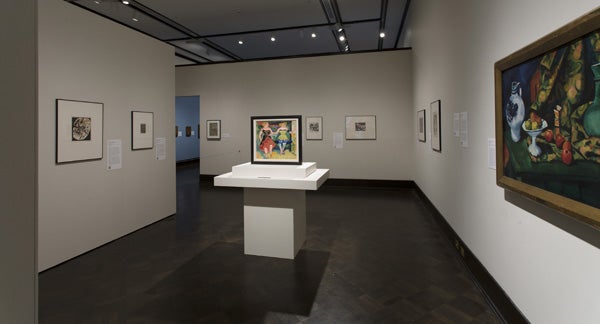An exhibition at the Jordan Schnitzer Museum of Art and a May symposium on German Expressionist works are helping to support art history courses this winter and spring taught by professors Sherwin Simmons and Joyce Cheng, as well as a May symposium.
The exhibition, which continues through May 19, features Max Pechstein’s double-sided painting Ballet Dancers (recto)/Two Women in Lamplight (verso), restored recently thanks in part to the Department of the History of Art and Architecture and the JSMA Academic Support Grant program, which included funds from the School of Architecture and Allied Arts. The symposium takes place May 18.

Originally displayed at A&AA, the oil painting was purchased in 1953 for $252 through the Widmer Art Fund, making the University of Oregon one of only six American universities to own a work by Pechstein. The painting was transferred from A&AA to the museum in 1967 and is now one of the collection’s most important works.
Pechstein was a member of Die Brücke (The Bridge), an important German artists’ group in the early 20th century. Ballet Dancers is initialed by the artist and dated 1912. Generous donations allowed it to be restored after 2010 and reframed to allow both sides to be viewed.
The exhibition has provided a unique learning opportunity for graduate students Megan Cekander and Sarah Hwang, both studying in the Department of the History of Art and Architecture. The students conducted extensive research to produce the accompanying interpretive materials.
For Hwang, the key challenge in crafting the labels “was figuring out how to educate the viewer enough for them to understand the significance of the print or painting in front of them without the labels becoming a textbook on German Expressionism,” she said. “Being a student, I am used to doing research and writing 15-20 page papers for classes, which is easy compared to writing 250-word labels. Also, this exhibition, even though it was created in conjunction with a course Sherwin Simmons is teaching next term, is for the general public. So again, the challenge of educating a variety of viewers with diverse backgrounds, but simultaneously being succinct is key.”
Student presentations about the works will be held May 15 from 5:30 to 7 p.m. in the Ford Lecture Hall of the JSMA.
 Other works by German Expressionists complement Pechstein’s double-sided canvas in the exhibition, including works from collections at the Portland Art Museum, Oregon State University, and the JSMA’s permanent collection that includes prints by Kandinsky, Kirchner, Klee, Kollwitz, Marc, Mueller, and Pechstein.
Other works by German Expressionists complement Pechstein’s double-sided canvas in the exhibition, including works from collections at the Portland Art Museum, Oregon State University, and the JSMA’s permanent collection that includes prints by Kandinsky, Kirchner, Klee, Kollwitz, Marc, Mueller, and Pechstein.
The exhibition is made possible by a JSMA Academic Support Grant, with thanks to matching funds from the School of Architecture and Allied Arts, the College of Arts and Sciences, the Office of the Provost, and University Relations.
Another JSMA Academic Support Grant will help fund the symposium about German Expressionism on Saturday, May 18, from 9 a.m. to 4:30 p.m. in Gerlinger Lounge. Speakers include Charles Haxthausen (Williams College), Rainer Rumold (Northwestern University), Kimberly Smith (Southwestern University), Naomi Hume (Seattle University), Sherwin Simmons (UO) and Ken Calhoon (UO). The public is welcome to attend this free event.
The Widmer Art Fund was established in 1942 with a $5,000 grant for the purchase of paintings for a permanent collection. Margaret Widmer was the daughter of a Lane County pioneer who became one of the earliest businessmen in Eugene. She graduated in 1897 from the UO Department of Education.


